History of the 1787 Brasher Doubloon
 LeeG
Posts: 12,162 ✭
LeeG
Posts: 12,162 ✭
I finished my series on the Classic Commems and will throw together some stuff on cool numismatic items on occasion.  Here is some history around the 1787 Brasher Doubloons.
Here is some history around the 1787 Brasher Doubloons.
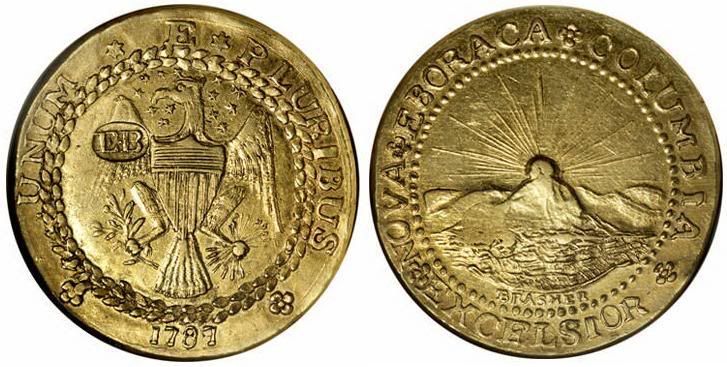
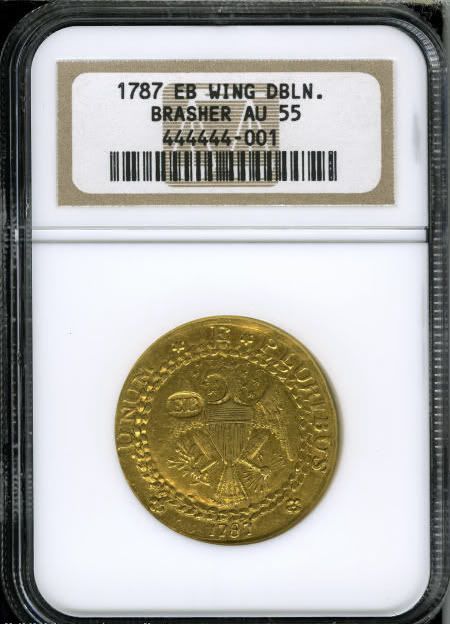
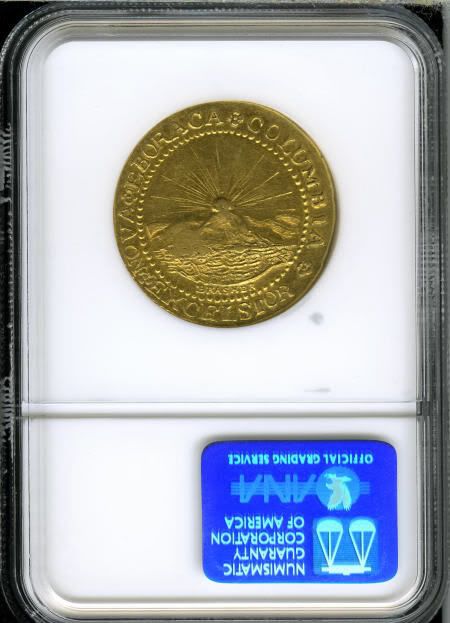
1787 New York Style Doubloon, EB punch on wing, sold for $2,415,000 at FUN 05
The following is a complete roster of the seven known "Doubloons"
The following six coins all have the "EB" hallmark punched over the eagle's wing:
1. National Numismatic Collection specimen
2. Yale University specimen
3. Walter Perschke specimen
4. The Garrett Specimen
5. American Numismatic Society specimen
6. The Dupont specimen
The following coin has the "EB" hallmark punched over the shield on the eagle's breast:
7. The Garrett Specimen
The "Half Doubloon" of the same design type, but on a smaller planchet, is currently unique!
1. National Numismatic Collection specimen
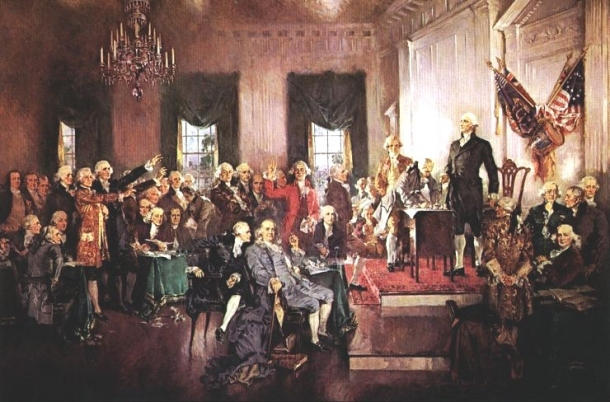
Scene at the signing of the Constitution in 1787. George Washington, who presided over the convention, is the figure standing on the dais. The central figures of the portrait are Alexander Hamilton, Benjamin Franklin and James Madison. Painting by Howard Chandler Christy (1873-1952).
The Brasher doubloons have intrigued numismatists for generations, though the exact story behind their creation remains a mystery. The first example turned up in a deposit of foreign gold pieces made to the Philadelphia Mint in 1838. The depositor simply wished to have his metal restruck into federal coins or ingots, and it was the sharp eye of Chief Coiner Adam Eckfeldt that spotted the significance of the hitherto unknown gold piece. For some years, Eckfeldt had taken it upon himself to set aside curious specimens which came into the Mint for recoining, paying for them from his own pocket. To this assemblage he added proof specimens of the current year's federal coinage, and these items formed the nucleus of the U. S. Mint's own coin collection, since relocated to the Smithsonian Institution's National Museum of American History in Washington, D.C.
The first mention of the Mint Collection's specimen appeared in 1846, when the Mint's unofficial historian and numismatist, W. E. DuBois, described it as "a very remarkable gold coin, equal in value to a doubloon, coined at New York in 1787." When published in 1858, J. H. Hickcox's seminal book An Historical Account of American Coinage included a written description of this coin's distinctive design. An even more influential and widely disseminated work was Professor Montroville W. Dickeson's The American Numismatic Manual, and it too made reference to this curious rarity, tentatively labeling it a pattern. This coin was finally illustrated in Sylvester S. Crosby's classic The Early Coins of America, which remains today the primary source of information about colonial and confederational coinage.
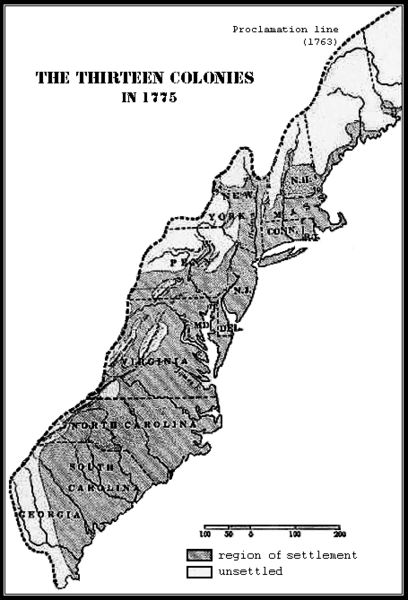
There’s no common agreement on which side of the Brasher doubloon is the obverse and which is the reverse. Though the eye is drawn toward the side bearing the distinctive ‘EB’ hallmark, set within an oval cartouche, most scholars have classified the landscape design as this coin’s obverse. Featured is a scene depicting the rising sun as it just clears the peak of a mountain. This is framed within a circle of small dots, while the name BRASHER appears below the landscape. Inscribed around the periphery are the legends NOVA EBORAC, COLUMBIA and EXCELSIOR, these separated by quatrefoils.
The reverse of this splendid coin is quite similar to that of the “EXCELSIOR” coppers of 1787, engraved by John Bailey, and it’s possible that Bailey may have participated in executing Brasher’s dies. The reverse is dominated by a heraldic eagle facing to the viewer’s left and bearing an American shield on its breast. In its right talons it grasps the olive branch of peace, in its left the arrows of war. A constellation of 13 five-point stars is arranged about the eagle’s head. A closed wreath encircles the eagle, and around the periphery is the legend E PLURIBUS UNUM, separated with six-point stars. Below is the date 1787, set apart from the legend by quatrefoils.
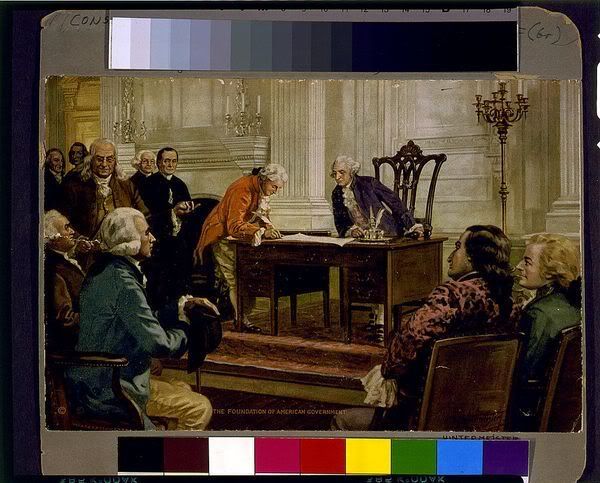
Collectors eagerly anticipated their first opportunity to bid on a specimen of the Brasher doubloon in 1873, when one was cataloged by W. H. Strobridge as part of the George F. Seavey Collection. To their chagrin, the Seavey Collection was purchased en bloc by Boston bean tycoon Lorin G. Parmelee, and the public sale never occurred. The publicity it generated, however, only served to further whet the appetites of numismatists for this prime rarity.
Only four examples were then known, of which one was a unique specimen with Brasher’s EB hallmark stamped into the eagle’s breast. Its existence within the enormous collection of Charles Bushnell was revealed to the numismatic fraternity in 1864. To this important coin went the honor of being the first Brasher doubloon actually sold at public auction. The year was 1882, and the prize of securing the Bushnell Collection for auction had gone to the young upstart partnership of Philadelphia brothers Henry and Samuel Chapman. The unique Bushnell specimen realized the then very impressive sum of $505. Its purchaser was the prominent New York dealer Edouard Frossard, who quickly placed the doubloon with one of the greatest collectors of that or any time, T. Harrison Garrett of Baltimore.

Map of Historic Philadelphia in the Late 18th Century
Garrett's enjoyment of his treasure was brief, however, as he perished in a boating accident on Chesapeake Bay in 1888. His collection of coins remained at his family's home, Evergreen House, and it passed to his son Robert. More than 30 years later, Robert, who had added only a few recent pieces to the collection, traded his coins to brother John Work Garrett in exchange for artworks, which were more to his liking. John Work, on the other hand, possessed a deep passion for numismatics, and he filled countless gaps in the family coin collection, making it one of the greatest ever assembled.
Following the death of John Work Garrett in 1942 and that of his wife some years later, the immense Garrett Collection of coins was willed to the Johns Hopkins University, along with Evergreen House in which to store the coins, books and other valuables it contained. As the years passed, the growing value of the coin collection made it an insurance liability, and it was removed from public display during the 1970s. In 1976, a portion was sold at auction, while the core of the collection remained inside a vault. Shortly thereafter, the University determined that having a valuable coin collection did not contribute to its primary mission, and the decision was made to sell the remaining items.
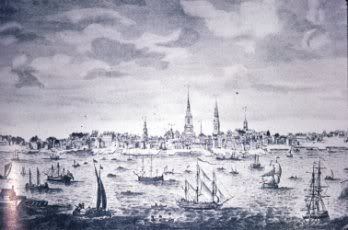
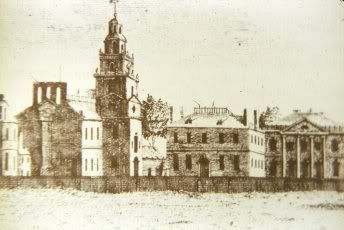
Philadelphia Skyline in 1787
A monumental, four-part sale was staged at the height of the coin market in 1979-81, and Sale 1 witnessed the offering of the finest known example of the “EB on wing” variety. Sale 4 was even more memorable, for it provided what was only the second opportunity since 1787 for collectors to bid on the unique "EB on breast" variety of the Brasher doubloon.
In addition to their great rarity, a contributing factor in the allure of the Brasher doubloons is the mystery surrounding their creation. No one disputes that they were the work of prominent New York City gold and silversmith Ephraim Brasher, whose surname appears on the coins, but the question of exactly why they were produced has generated much speculation over the years. Brasher (pronounced BRAYzher) is known to have submitted a petition to produce copper coins to the New York State Assembly in 1787, possibly in partnership with John Bailey. One theory holds that the dies used to coin the gold doubloons were actually engraved for this copper coinage and that Brasher struck off a few pieces in gold to impress the state legislators with the quality of his work. Indeed, one side of his coin bears mottos relating to New York: NOVA EBORAC is the Latin name for this state, while EXCELSIOR is New York's own motto, translated as either "more excellent" or, as used in the state's literature, "ever upward." At this time, Brasher's business address was 77 Queen Street in the Wall Street area of New York City, and it may be presumed that his doubloons were produced at that location.
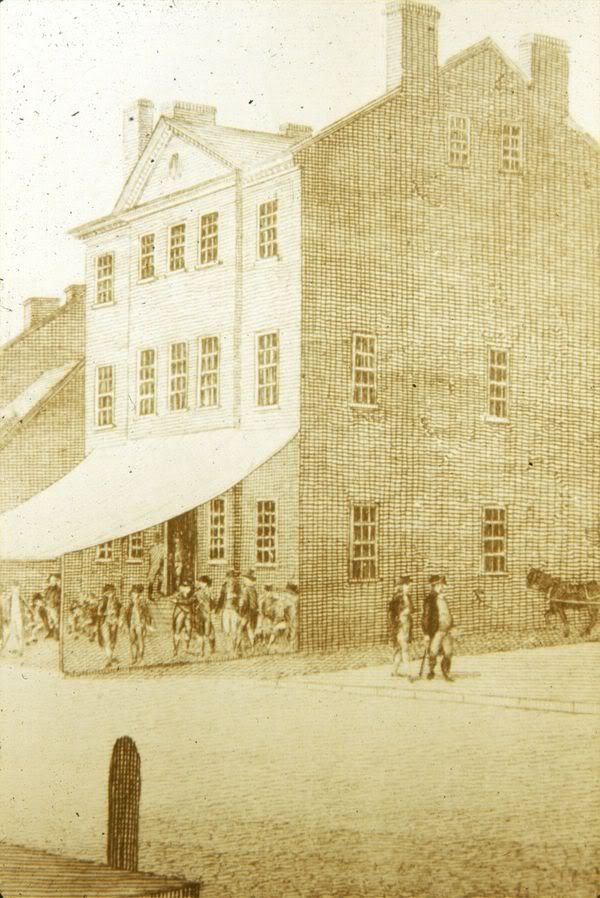
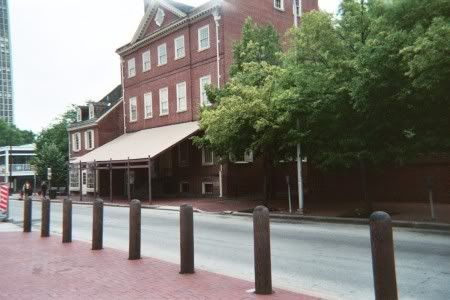
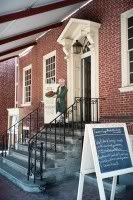
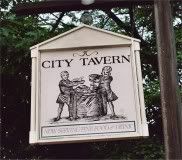
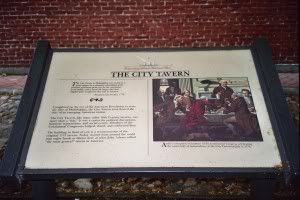
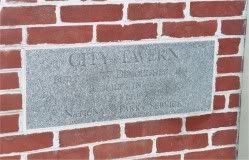
City Tavern on 2nd and Walnut Street in Philadelphia was built in 1773, and also called the Merchants' Coffee House, which was the political and business center of Philadelphia. All the leading persons who signed the Declaration of Independence and the Constitution met here. In fact, the Founders of the Constitution had their farewell dinner here on September 17, 1787. George Washington's diary indicates that he would dine and talk politics with other delegates here at least once a week. William Samuel Johnson, Rufus King, and John Lansing resided here during the Constitutional Convention.
The term "doubloon" does not appear on the coins themselves, which carry no stated value. It was applied to them by Mint officer W. E. DuBois solely on the basis of their size and weight, which corresponds closely to that of Spain's eight escudos gold piece, commonly known as a doubloon. The lack of a stated value is of no significance, as contemporary English gold coins and the early United States gold coins were similarly unmarked and circulated on the basis of their intrinsic value. Whether the Brasher coins actually circulated is uncertain, though most show some degree of wear. If the coins were produced as souvenir or presentation pieces, they may have obtained their wear through use as pocket pieces or from unskilled cleaning.
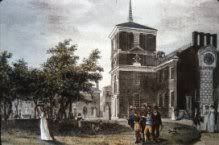
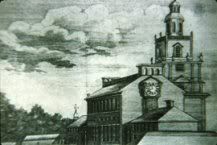
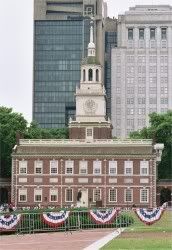
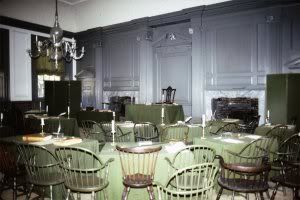
Independence Hall, 5th/6th & Chestnut Streets, Philadelphia. Construction of the Pennsylvania State House, later known as Independence Hall, began in 1732 and was completed in 1753. The building has performed many functions, including being the warehouse for the "memorabilia" of the American Founding and the inspiration for the Christy painting in the first half of the twentieth century. The National Park Service, in 1950, decided to return the building to its original appearance in anticipation of the bicentennial of the signing of Declaration of Independence and the Constitution. These two signings make Independence Hall the most sacred ground in the political history of the United States.
The historic value of the Brasher doubloons lies in Brasher's prominence as an assayer during the years preceding the establishment of the United States Mint. Held in high esteem for both his skill and integrity, Ephraim Brasher was frequently called upon to perform assays on the various gold coins then current in the infant nation. These consisted of a motley mix of European and Latin American issues whose sole value rested in their weight and fineness, which Brasher was asked to guarantee by affixing his EB hallmark. Also contributing to his importance as a figure during the Confederational period were his close personal ties to George Washington. The two were in fact next door neighbors at the time the Brasher gold pieces were made. Ephraim Brasher was residing at No. 1 Cherry Street in lower Manhattan when Washington relocated to No. 3 Cherry Street. Brasher actually furnished silverware for the future president on more than one occasion, and Washington even owned two tea trays bearing the prestigious EB hallmark.
Composition:
Estimated .917 gold, .083 alloy
Weight:
Approximately 26.66 grams
Diameter
Approximately 28.6 millimeters
Edge
Plain
Information from the "Coin Encyclopedia" at NGC



1787 New York Style Doubloon, EB punch on wing, sold for $2,415,000 at FUN 05
The following is a complete roster of the seven known "Doubloons"
The following six coins all have the "EB" hallmark punched over the eagle's wing:
1. National Numismatic Collection specimen
2. Yale University specimen
3. Walter Perschke specimen
4. The Garrett Specimen
5. American Numismatic Society specimen
6. The Dupont specimen
The following coin has the "EB" hallmark punched over the shield on the eagle's breast:
7. The Garrett Specimen
The "Half Doubloon" of the same design type, but on a smaller planchet, is currently unique!
1. National Numismatic Collection specimen

Scene at the signing of the Constitution in 1787. George Washington, who presided over the convention, is the figure standing on the dais. The central figures of the portrait are Alexander Hamilton, Benjamin Franklin and James Madison. Painting by Howard Chandler Christy (1873-1952).
The Brasher doubloons have intrigued numismatists for generations, though the exact story behind their creation remains a mystery. The first example turned up in a deposit of foreign gold pieces made to the Philadelphia Mint in 1838. The depositor simply wished to have his metal restruck into federal coins or ingots, and it was the sharp eye of Chief Coiner Adam Eckfeldt that spotted the significance of the hitherto unknown gold piece. For some years, Eckfeldt had taken it upon himself to set aside curious specimens which came into the Mint for recoining, paying for them from his own pocket. To this assemblage he added proof specimens of the current year's federal coinage, and these items formed the nucleus of the U. S. Mint's own coin collection, since relocated to the Smithsonian Institution's National Museum of American History in Washington, D.C.
The first mention of the Mint Collection's specimen appeared in 1846, when the Mint's unofficial historian and numismatist, W. E. DuBois, described it as "a very remarkable gold coin, equal in value to a doubloon, coined at New York in 1787." When published in 1858, J. H. Hickcox's seminal book An Historical Account of American Coinage included a written description of this coin's distinctive design. An even more influential and widely disseminated work was Professor Montroville W. Dickeson's The American Numismatic Manual, and it too made reference to this curious rarity, tentatively labeling it a pattern. This coin was finally illustrated in Sylvester S. Crosby's classic The Early Coins of America, which remains today the primary source of information about colonial and confederational coinage.

There’s no common agreement on which side of the Brasher doubloon is the obverse and which is the reverse. Though the eye is drawn toward the side bearing the distinctive ‘EB’ hallmark, set within an oval cartouche, most scholars have classified the landscape design as this coin’s obverse. Featured is a scene depicting the rising sun as it just clears the peak of a mountain. This is framed within a circle of small dots, while the name BRASHER appears below the landscape. Inscribed around the periphery are the legends NOVA EBORAC, COLUMBIA and EXCELSIOR, these separated by quatrefoils.
The reverse of this splendid coin is quite similar to that of the “EXCELSIOR” coppers of 1787, engraved by John Bailey, and it’s possible that Bailey may have participated in executing Brasher’s dies. The reverse is dominated by a heraldic eagle facing to the viewer’s left and bearing an American shield on its breast. In its right talons it grasps the olive branch of peace, in its left the arrows of war. A constellation of 13 five-point stars is arranged about the eagle’s head. A closed wreath encircles the eagle, and around the periphery is the legend E PLURIBUS UNUM, separated with six-point stars. Below is the date 1787, set apart from the legend by quatrefoils.

Collectors eagerly anticipated their first opportunity to bid on a specimen of the Brasher doubloon in 1873, when one was cataloged by W. H. Strobridge as part of the George F. Seavey Collection. To their chagrin, the Seavey Collection was purchased en bloc by Boston bean tycoon Lorin G. Parmelee, and the public sale never occurred. The publicity it generated, however, only served to further whet the appetites of numismatists for this prime rarity.
Only four examples were then known, of which one was a unique specimen with Brasher’s EB hallmark stamped into the eagle’s breast. Its existence within the enormous collection of Charles Bushnell was revealed to the numismatic fraternity in 1864. To this important coin went the honor of being the first Brasher doubloon actually sold at public auction. The year was 1882, and the prize of securing the Bushnell Collection for auction had gone to the young upstart partnership of Philadelphia brothers Henry and Samuel Chapman. The unique Bushnell specimen realized the then very impressive sum of $505. Its purchaser was the prominent New York dealer Edouard Frossard, who quickly placed the doubloon with one of the greatest collectors of that or any time, T. Harrison Garrett of Baltimore.

Map of Historic Philadelphia in the Late 18th Century
Garrett's enjoyment of his treasure was brief, however, as he perished in a boating accident on Chesapeake Bay in 1888. His collection of coins remained at his family's home, Evergreen House, and it passed to his son Robert. More than 30 years later, Robert, who had added only a few recent pieces to the collection, traded his coins to brother John Work Garrett in exchange for artworks, which were more to his liking. John Work, on the other hand, possessed a deep passion for numismatics, and he filled countless gaps in the family coin collection, making it one of the greatest ever assembled.
Following the death of John Work Garrett in 1942 and that of his wife some years later, the immense Garrett Collection of coins was willed to the Johns Hopkins University, along with Evergreen House in which to store the coins, books and other valuables it contained. As the years passed, the growing value of the coin collection made it an insurance liability, and it was removed from public display during the 1970s. In 1976, a portion was sold at auction, while the core of the collection remained inside a vault. Shortly thereafter, the University determined that having a valuable coin collection did not contribute to its primary mission, and the decision was made to sell the remaining items.


Philadelphia Skyline in 1787
A monumental, four-part sale was staged at the height of the coin market in 1979-81, and Sale 1 witnessed the offering of the finest known example of the “EB on wing” variety. Sale 4 was even more memorable, for it provided what was only the second opportunity since 1787 for collectors to bid on the unique "EB on breast" variety of the Brasher doubloon.
In addition to their great rarity, a contributing factor in the allure of the Brasher doubloons is the mystery surrounding their creation. No one disputes that they were the work of prominent New York City gold and silversmith Ephraim Brasher, whose surname appears on the coins, but the question of exactly why they were produced has generated much speculation over the years. Brasher (pronounced BRAYzher) is known to have submitted a petition to produce copper coins to the New York State Assembly in 1787, possibly in partnership with John Bailey. One theory holds that the dies used to coin the gold doubloons were actually engraved for this copper coinage and that Brasher struck off a few pieces in gold to impress the state legislators with the quality of his work. Indeed, one side of his coin bears mottos relating to New York: NOVA EBORAC is the Latin name for this state, while EXCELSIOR is New York's own motto, translated as either "more excellent" or, as used in the state's literature, "ever upward." At this time, Brasher's business address was 77 Queen Street in the Wall Street area of New York City, and it may be presumed that his doubloons were produced at that location.






City Tavern on 2nd and Walnut Street in Philadelphia was built in 1773, and also called the Merchants' Coffee House, which was the political and business center of Philadelphia. All the leading persons who signed the Declaration of Independence and the Constitution met here. In fact, the Founders of the Constitution had their farewell dinner here on September 17, 1787. George Washington's diary indicates that he would dine and talk politics with other delegates here at least once a week. William Samuel Johnson, Rufus King, and John Lansing resided here during the Constitutional Convention.
The term "doubloon" does not appear on the coins themselves, which carry no stated value. It was applied to them by Mint officer W. E. DuBois solely on the basis of their size and weight, which corresponds closely to that of Spain's eight escudos gold piece, commonly known as a doubloon. The lack of a stated value is of no significance, as contemporary English gold coins and the early United States gold coins were similarly unmarked and circulated on the basis of their intrinsic value. Whether the Brasher coins actually circulated is uncertain, though most show some degree of wear. If the coins were produced as souvenir or presentation pieces, they may have obtained their wear through use as pocket pieces or from unskilled cleaning.




Independence Hall, 5th/6th & Chestnut Streets, Philadelphia. Construction of the Pennsylvania State House, later known as Independence Hall, began in 1732 and was completed in 1753. The building has performed many functions, including being the warehouse for the "memorabilia" of the American Founding and the inspiration for the Christy painting in the first half of the twentieth century. The National Park Service, in 1950, decided to return the building to its original appearance in anticipation of the bicentennial of the signing of Declaration of Independence and the Constitution. These two signings make Independence Hall the most sacred ground in the political history of the United States.
The historic value of the Brasher doubloons lies in Brasher's prominence as an assayer during the years preceding the establishment of the United States Mint. Held in high esteem for both his skill and integrity, Ephraim Brasher was frequently called upon to perform assays on the various gold coins then current in the infant nation. These consisted of a motley mix of European and Latin American issues whose sole value rested in their weight and fineness, which Brasher was asked to guarantee by affixing his EB hallmark. Also contributing to his importance as a figure during the Confederational period were his close personal ties to George Washington. The two were in fact next door neighbors at the time the Brasher gold pieces were made. Ephraim Brasher was residing at No. 1 Cherry Street in lower Manhattan when Washington relocated to No. 3 Cherry Street. Brasher actually furnished silverware for the future president on more than one occasion, and Washington even owned two tea trays bearing the prestigious EB hallmark.
Composition:
Estimated .917 gold, .083 alloy
Weight:
Approximately 26.66 grams
Diameter
Approximately 28.6 millimeters
Edge
Plain
Information from the "Coin Encyclopedia" at NGC
0
Comments
Worry is the interest you pay on a debt you may not owe.
"Paper money eventually returns to its intrinsic value---zero."----Voltaire
"Everything you say should be true, but not everything true should be said."----Voltaire
Hey Lee
Thanks buddy.
The Brasher Doubloon is my fantasy dream coin.
If I have forgotten to Thank You for all your great informative posts
I want to say....................
Stefanie
.
CoinsAreFun Toned Silver Eagle Proof Album
.
Gallery Mint Museum, Ron Landis& Joe Rust, The beginnings of the Golden Dollar
.
More CoinsAreFun Pictorials NGC
Great information !
FYI - attached is 1787 Brasher Doubloon - Robinson Medal. Extremely Rare 1861 copy ( only 25 made ) .. but as close as I could get to a multi-million dollar original. Addtional information on Brasher is at:
link
"many contacts among the Lumberjacks "
NGC Registry AOEDAD sets:
Set #1 Major Expositions
Set #2 So-called Dollar Collections
So-called $50 Slug Facsimiles
Bashlow re-strikes
It's intresting to note, that the one pictured with the "EB" stamped on the wing & the one stamped on the breast were recently bought by Rare Coin Wholesalers, and featured at the Long Beach Show.
The posts are just GREAT!
Is there a way to get a listing/link to all the posts you've done?
VR, Jeff
<< <i>Thanks for sharing...
It's intresting to note, that the one pictured with the "EB" stamped on the wing & the one stamped on the breast were recently bought by Rare Coin Wholesalers, and featured at the Long Beach Show. >>
They were purchased 3 years ago.
Edited to add: Thanks Lee for posting some terrific information.
The Morris "townhome" at 6th and High St. was actually used as the first Presidential residence by George Washington. An exact replica is currently being re-constructed on the site by the National Parks Service.
Robert Morris (and his family) moved next door into the guest house and he was a frequent attendee at Washington's official state dinners. Washington's slaves quarters were in the rear of the grounds, and the entrance to that structure was less than 10 feet from where the Liberty Bell was housed.
The United States Mint (which is not depicted) was in the middle of the block of 7th Street, north of High Street, located on the east side. Henry Voigt, the Cheif Coiner lived on the same side of the street, just south of the alley across from the Mint. David Rittenhouse, the Mint Director lived on the corner of 7th & Mulberry St. a half block away from the Mint.
The Bingham residence at 3rd & Spruce is where Ann Bingham (wife of William), the model seen on the Draped Bust U.S. silver coinage, lived. The Bingham's gave many important social and political parties at their mansion.
As for the Brasher doubloon's, does anyone have electronic images of all known specimens along with their respective exact weights? The listed weights we now have are not correct, especially the worn punch on the breast example, which Breen copied at 26.41grs. That would certainly be useful for researchers, as I know the planchets are not identical.
The rising sun over the mountain was chosen to depict a scene from the Hudson River highlands in New York.
Has anyone ever mentioned the re-punching of many of the letters on the c/s breast example, along with the smaller diameter planchet which follows the inner scribe lines seen on the c/s wing examples?